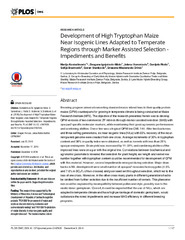| dc.creator | Kostadinović, Marija | |
| dc.creator | Ignjatović-Micić, Dragana | |
| dc.creator | Ristić, Danijela | |
| dc.creator | Mladenović Drinić, Snežana | |
| dc.creator | Vančetović, Jelena | |
| dc.creator | Božinović, Sofija | |
| dc.creator | Stanković, Goran | |
| dc.date.accessioned | 2019-05-16T12:19:21Z | |
| dc.date.available | 2019-05-16T12:19:21Z | |
| dc.date.issued | 2016 | |
| dc.identifier.issn | 1932-6203 | |
| dc.identifier.uri | http://rik.mrizp.rs/handle/123456789/621 | |
| dc.description.abstract | Breeding program aimed at converting standard maize inbred lines to their quality protein maize (QPM) counterparts for growing in temperate climate is being conducted at Maize Research Institute (MRI). The objective of the research presented herein was to develop QPM versions of two commercial ZP inbreds through marker assisted selection (MAS) with opaque2 specific molecular markers, while maintaining their good agronomic performances and combining abilities. Donor line was a tropical QPM line CML 144. After two backcross and three selfing generations, six near isogenic lines (NILs) with 93% recovery of the recurrent parent genome were created from one cross. Average increments of 30% in tryptophan content and 36% in quality index were obtained, as well as kernels with less than 25% opaque endosperm. Grain yield was increased by 11-31% and combining abilities of the improved lines were on a par with the original line. Correlations between biochemical and agronomic parameters revealed that selection for plant height, ear length and kernel row number together with tryptophan content could be recommended for development of QPM with this material. However, several impediments emerged during selection. Major drawbacks in NIL development were small number of opaque2 recessive homozygotes (4.5% and 7.6% in BC2F2 of two crosses) and poor seed set throughout selection, which led to the loss of one cross. Moreover, in the other cross many plants in different generations had to be omitted from further selection due to the insufficient number of kernels. This phenomenon could be explained by incompatibility between pollen and style, possibly due to the exotic donor germplasm. Overall, it could be expected that the use of NILs, which are adapted to temperate climate and have high percentage of domestic germplasm, would outbalance the noted impediments and increase MAS efficiency in different breeding programs. | en |
| dc.publisher | Public Library Science, San Francisco | |
| dc.relation | info:eu-repo/grantAgreement/MESTD/Technological Development (TD or TR)/31068/RS// | |
| dc.relation | info:eu-repo/grantAgreement/MESTD/Technological Development (TD or TR)/31028/RS// | |
| dc.rights | openAccess | |
| dc.rights.uri | https://creativecommons.org/licenses/by/4.0/ | |
| dc.source | PLOS ONE | |
| dc.title | Development of High Tryptophan Maize Near Isogenic Lines Adapted to Temperate Regions through Marker Assisted Selection Impediments and Benefits | en |
| dc.type | article | |
| dc.rights.license | BY | |
| dc.citation.volume | 11 | |
| dc.citation.issue | 12 | |
| dc.citation.other | 11(12): - | |
| dc.citation.rank | M21 | |
| dc.identifier.wos | 000389587100137 | |
| dc.identifier.doi | 10.1371/journal.pone.0167635 | |
| dc.identifier.pmid | 27936171 | |
| dc.identifier.scopus | 2-s2.0-85006043627 | |
| dc.identifier.fulltext | http://rik.mrizp.rs//bitstream/id/2560/619.pdf | |
| dc.type.version | publishedVersion | |


